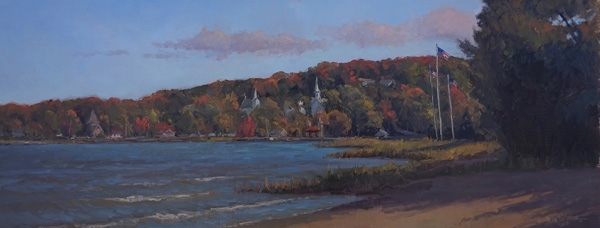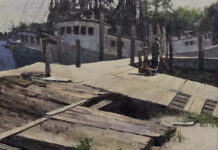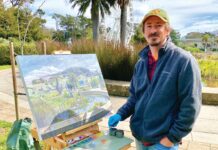
Nebraska painter Debra Joy Groesser may prefer to paint outside, but she has a system down for working indoors — one that some of her students find revelatory. She’ll share it in person at the Plein Air Convention & Expo (PACE), April 13-17 in Monterey, California.

“Behind the Sawmill,” by Debra Joy Groesser, oil, 10 x 20 in.
Groesser, the president of the American Impressionist Society, is crazy about the Monterey coastline. “That whole area is my favorite place in the entire world,” she says. “My favorite subjects have dramatic lighting, and I love painting those cliffs out there.” So she will be painting a coastal scene from the Big Sur-Carmel-Monterey area at the Plein Air Convention as her demonstration. But wait — the demos are inside.

The plein air study for “At the Cliff’s Edge,” oil, 9 x 12 in.

The scene depicted in “At the Cliff’s Edge.”
“I’ll have plein air studies and photographs,” Groesser explains. “When I paint in the studio I paint with a combination of plein air reference and photos — but I only use photos for detail or drawing, not color. I prefer to use plein air for color because it is so much more accurate. I always tell my students, if you are going to paint from photos, be sure to paint often from life. Realize where and how to enhance what you see in the photo, and how not be a slave to the photo.”
Groesser likes canvases with a severely horizontal format– substrates that are 12″ x 30″ are typical. In the studio, she’ll go as large as 36″ x 48″. As she goes up in canvas size, she goes up in brush size. “Otherwise, I get too detailed,” she says. Groesser says the size of the canvas for her demo at PACE will be determined by how much time she is allotted, but it will be at least 11″ x 14″.

The studio painting: “At the Cliff’s Edge,” by Debra Joy Groesser, oil, 24 x 30 in.
She knows her subject, and she knows her format. Groesser also knows one area that she’ll talk about. “My students like it when I bring in a studio painting, the plein air studies I painted it from, and the photo of the area, and show how they all work together. For some, it’s the biggest light-bulb moment they experience, seeing how different the painting is from the photo. Once you do enough plein air painting, you can look at a piece and tell if it was done from a photograph.”




